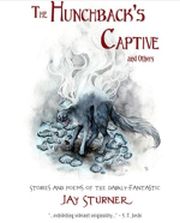
The Hunchback’s Captive and Others: Stories and Poems of the Darkly Fantastic (Fairy Thrush Press)
by Jay Sturner
Jay Sturner’s collection—The Hunchback’s Captive and Others: Stories and Poems of the Darkly Fantastic (Fairy Thrush Press, 2019)—is comprised of 24 pieces. The cover art, by Amelia Joyce Leonards, features a cait sidhe (pronounced “caught shee”) from Irish folklore, which is a “fairy cat.” It perfectly captures the sentiment of the 96-page collection, which is accurately summarized by S. T. Joshi who says the work exhibits “vibrant originality” and will thrust you “into the realms of ethereal fantasy and clutching horror.” And of these “phantasmagorical assortment of surreal wonders, bone-chilling horrors, and intimate whimsies,” David Lee Summers says that each of these stories and poems is “like holding a mirror to our most hidden selves.”
I reviewed an earlier version of the manuscript and cataloged my comments/impressions on the then 18 pieces. Collectively, my impression of the collection is consistent with the two poet-writers mentioned above, who provided blurbs to which I was not privy to at the time of my review. Though all the stories and poems in collection were enjoyable, the ones marked with an asterisk (*) are among my favorites:
The opening prose poem, “Sketch by Sketch,” is a musing on Pan, and perhaps a metaphor, with the great line: Today you’ll find me in the green layers beyond the city, sidestepping the coiled corpses of men’s dreams. “Faerystruck Down” is rich with anapests and propels the reader into the fantasy realm. “What We Know of Goddesses” alludes to the key roles women have in society, even among the gods. “Strings,” a bizarro piece, originally closed the series. (‘Bizarro fiction is a contemporary literary genre, which often uses elements of absurdism, satire, and the grotesque, along with pop-surrealism and genre fiction staples, in order to create subversive, weird, and entertaining works.’ – Wikipedia.) “The Girl with the Crooked Spine” is simply spooky, spooky-good. In an excerpt from “Misery of He Who is Outside the Realm of Man,” notice the nihilism and the brilliant oxymoron at the core of man: But he who is outside the realm of man, and whose core is a diamond of misery, must endure his current destiny without fail, for always there is war and disease, starvation, murder, agedness . . . “Time to Grow Up Where There’s No Time at All” has poetic swaths like Guiding my dreams beyond the moonlight. “Intimate Universes” is enriched with surrealism and personification: A singularity popped off the tongue of a howling black hole. “Belch” is a prose poem that is non-flattering concerning the nature of man/mankind. “Charon Falls into the Styx” was the first story I read (having started at random) and seems to be a Dante-influenced piece but with an unexpected fate for the boatman. “The Hunchback’s Captive”*, the title story, begins with an intriguing image: I was facedown in swamp muck beneath a moss green moon, gasping for air… and continues into a relentless series of nightmarish dreamscapes symbolic of our socio-economic times. “The Politician’s New Heart” makes an environmental statement: free of pollution, and boldly green. (“Post Funeral Mission to Mars,” “Intimate Universes,” and “Penumbra” were not in the original manuscript.) “The Unfortunate Heartbreak of Faritook the Earwig” is a hoot and an insect metaphor for adolescent human sexuality. “Red Icicles” is a cute story of aviary revenge. “Ghoul of the Enamel”* is a story with a twist on the tooth fairy. “Deal Down at the Hospital”* has hints of Stephen King’s sinister clown, It, but actually has a sense of symbolic retribution—another Dante influence. “The Tramp Clown’s Secret”* is a short story full of twists. (“Not for Mortal Eyes” was not in the original manuscript.) “The Blackout Killer” is spooky, ghoulish and twisted, and originally was the penultimate piece ending this clever and imaginative series of stories and poems. “Making Amends” is another Dante-like poem. (Finally, the closing pieces, “Spiral of Flies” and “The Dark Island,” were also not in the original manuscript, and therefore not reviewed.)
I can recommend this collection to the aficionados of fantasy-horror genre and the book is available through Amazon
—John C. Mannone, reviewer and poetry editor of Abyss & Apex, and author of the short story collection Dark Wind, Dark Waters forthcoming in 2020.
